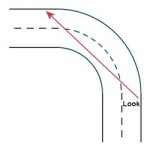Global Navigation

Main Navigation
Sub-Navigation

Content
How much we need to slow down will be determined by the speed at which we are riding and the severity (tightness) of the curve. Likewise, we will probably slow more for a blind curve; one that has something obstructing our view of the exit or in which we can't see the whole curve. The important thing is that we slow before we enter the curve. We want to get all our slowing done while our bike is upright and we have the maximum traction available for braking force - before we need any traction for cornering force.
Step two is to look to the exit of the curve. This means turning our head and focusing our eyes on where we want to be as we leave the curve. Visual control is fundamental to the smooth operation of our motorcycle. We want to turn our head because we go where we look.
 As
we turn our head, we sweep the road surface with our eyes to
identify anything we need to deal with as we glide through the
corner. Ideally, we've already noticed any major obstructions as
we approached the turn so we're only scanning for potential road
surface problems. Of course, if we can't see the entire curve
before we get to it or as we go through it, we have to assume
the worst and go into it a little slower.
As
we turn our head, we sweep the road surface with our eyes to
identify anything we need to deal with as we glide through the
corner. Ideally, we've already noticed any major obstructions as
we approached the turn so we're only scanning for potential road
surface problems. Of course, if we can't see the entire curve
before we get to it or as we go through it, we have to assume
the worst and go into it a little slower.
As we look through the curve, all the way to the end of it, we also identify the path of travel we want to use going around the turn. Our path of travel will vary depending on many things like traffic, radius, field of vision, but the primary intent is to make the curve as wide as possible. We'll examine path of travel later. The wider we make the turn, the less we need to lean our bike and the less traction we need for cornering force.
Sidebar
Footer
Copyright 1996-2015 Chuck Miles All Rights Reserved
All information on this site, including all articles, are copyrighted materials belonging to Chuck Miles.
Design: Made in Austria | Author: G. Wolfgang



